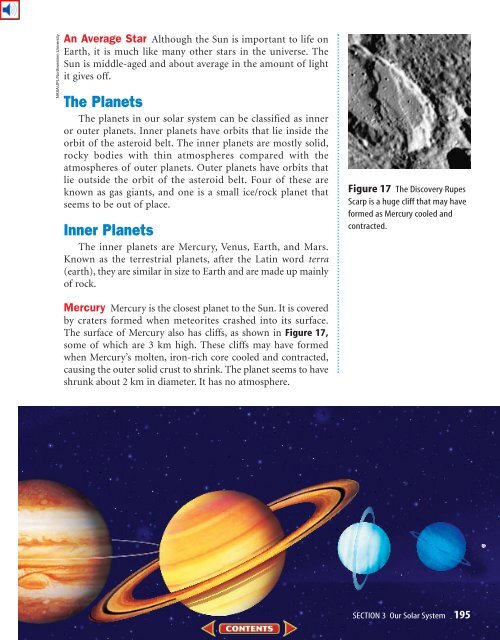Chapter 7: Earth in Space
Chapter 7: Earth in Space
Chapter 7: Earth in Space
You also want an ePaper? Increase the reach of your titles
YUMPU automatically turns print PDFs into web optimized ePapers that Google loves.
NASA/JPL/Northwestern University<br />
An Average Star Although the Sun is important to life on<br />
<strong>Earth</strong>, it is much like many other stars <strong>in</strong> the universe. The<br />
Sun is middle-aged and about average <strong>in</strong> the amount of light<br />
it gives off.<br />
The Planets<br />
The planets <strong>in</strong> our solar system can be classified as <strong>in</strong>ner<br />
or outer planets. Inner planets have orbits that lie <strong>in</strong>side the<br />
orbit of the asteroid belt. The <strong>in</strong>ner planets are mostly solid,<br />
rocky bodies with th<strong>in</strong> atmospheres compared with the<br />
atmospheres of outer planets. Outer planets have orbits that<br />
lie outside the orbit of the asteroid belt. Four of these are<br />
known as gas giants, and one is a small ice/rock planet that<br />
seems to be out of place.<br />
Inner Planets<br />
The <strong>in</strong>ner planets are Mercury, Venus, <strong>Earth</strong>, and Mars.<br />
Known as the terrestrial planets, after the Lat<strong>in</strong> word terra<br />
(earth), they are similar <strong>in</strong> size to <strong>Earth</strong> and are made up ma<strong>in</strong>ly<br />
of rock.<br />
Mercury Mercury is the closest planet to the Sun. It is covered<br />
by craters formed when meteorites crashed <strong>in</strong>to its surface.<br />
The surface of Mercury also has cliffs, as shown <strong>in</strong> Figure 17,<br />
some of which are 3 km high. These cliffs may have formed<br />
when Mercury’s molten, iron-rich core cooled and contracted,<br />
caus<strong>in</strong>g the outer solid crust to shr<strong>in</strong>k. The planet seems to have<br />
shrunk about 2 km <strong>in</strong> diameter. It has no atmosphere.<br />
Figure 17 The Discovery Rupes<br />
Scarp is a huge cliff that may have<br />
formed as Mercury cooled and<br />
contracted.<br />
SECTION 3 Our Solar System 195

















